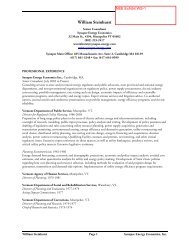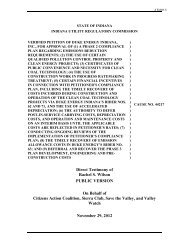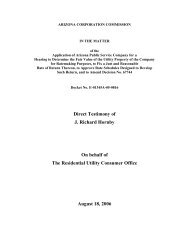Best Practices in Energy Efficiency Program Screening - Synapse ...
Best Practices in Energy Efficiency Program Screening - Synapse ...
Best Practices in Energy Efficiency Program Screening - Synapse ...
You also want an ePaper? Increase the reach of your titles
YUMPU automatically turns print PDFs into web optimized ePapers that Google loves.
Table of Contents<br />
EXECUTIVE SUMMARY ......................................................................................................... 1<br />
1. INTRODUCTION ............................................................................................................... 9<br />
2. TESTS FOR SCREENING ENERGY EFFICIENCY PROGRAMS ............................................. 12<br />
2.1 Description of the Cost-Effectiveness Tests ............................................. 12<br />
2.2 Implications of the Cost-Effectiveness Tests ............................................ 14<br />
2.3 Decid<strong>in</strong>g Whether to Apply the PAC, TRC or Societal Test ...................... 17<br />
2.4 Recommendations for Which Tests to Apply ............................................ 19<br />
3. CALCULATION OF AVOIDED COSTS ............................................................................... 22<br />
3.1 Introduction ................................................................................................... 22<br />
3.2 Avoided <strong>Energy</strong> Costs ................................................................................. 22<br />
3.3 Avoided Capacity Costs .............................................................................. 23<br />
3.4 Avoided Transmission and Distribution Costs .......................................... 24<br />
3.5 Avoided Environmental Compliance Costs ............................................... 26<br />
3.6 Price Suppression Effects <strong>in</strong> Wholesale Electricity Markets ................... 29<br />
3.7 L<strong>in</strong>e Losses ................................................................................................... 30<br />
3.8 Illustrative Example ...................................................................................... 30<br />
4. CAPTURING ALL THE IMPACTS OF ENERGY EFFICIENCY ................................................ 33<br />
4.1 Other <strong>Program</strong> Impacts ................................................................................ 33<br />
4.2 Free-Riders, Spillover and Market Transformation ................................... 41<br />
4.3 The Risk Benefits of <strong>Energy</strong> <strong>Efficiency</strong> ...................................................... 45<br />
5. EFFICIENCY SCREENING METHODOLOGICAL ISSUES ..................................................... 50<br />
5.1 Discount Rate ............................................................................................... 50<br />
5.2 Study Period ................................................................................................. 54<br />
5.3 Screen<strong>in</strong>g Level ............................................................................................ 55<br />
6. SUMMARY OF RECOMMENDATIONS ............................................................................... 58<br />
REFERENCES .................................................................................................................... 62<br />
APPENDIX A – ILLUSTRATIVE EXAMPLE AND AVOIDED COSTS............................................ 67<br />
<strong>Best</strong> <strong>Practices</strong> <strong>in</strong> <strong>Energy</strong> <strong>Efficiency</strong> <strong>Program</strong> Screen<strong>in</strong>g | www.nhpci.org







